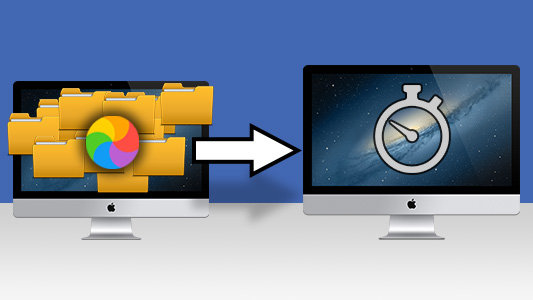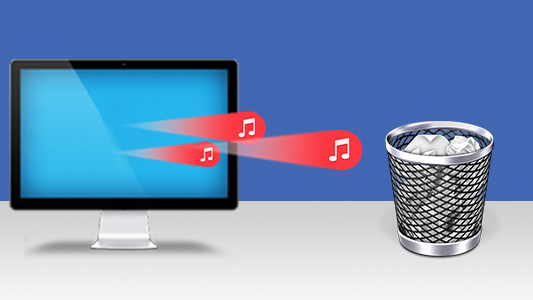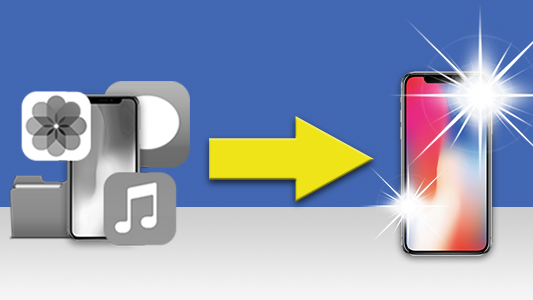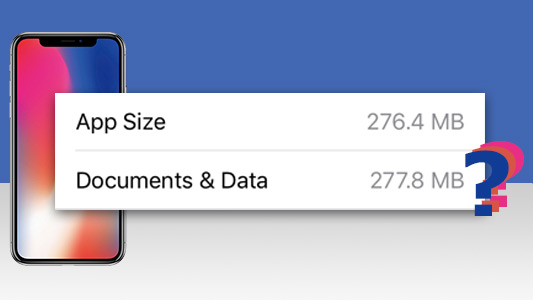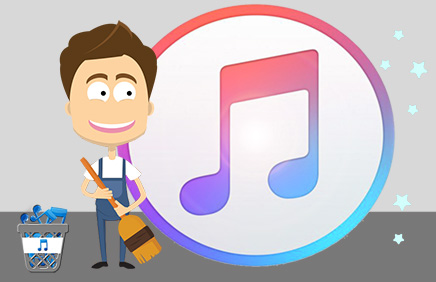When your Mac starts running out of storage, it can slow down dramatically. The good news is you can usually fix this quickly. This article walks you through 10 straightforward steps to free up space by removing unnecessary files and clearing room for what you actually need, whether you’re tech-savvy or not.
The 10 sections below cover the biggest space-hogging culprits on your Mac and how to clean them up. Jump straight to a section:
- How to check Storage on Mac or Macbook
- Mac OS Storage Management
- Find Duplicate Files Mac
- Unused Apps- Uninstall Programs on Mac
- How to delete downloads on Mac
- Find and remove large media files
- Delete Finder/iTunes backups
- Delete Temporary Files on Mac
- Taking out the Trash
- Move files into external storage
1. How to check Storage on Mac or Macbook
To find out how much space is available on your Mac:
- Open the Apple menu (the Apple icon in the top-left corner of your screen).
- Click "About this Mac".
- Click "Storage".
This overview will show what categories are taking up the most space, as well as how much space is available on your Mac.

If you hover over each coloured section in the bar, you'll see what each segment represents. Sections like Music, Photos, Messages and Mail are easy to see what kind of data is stored there - however there's also a mystery grey section called "Other".
"Other" on Mac can make up an awful lot of storage, and it's not immediately apparent what is stored as Other.
The truth is that files which do not fit neatly into other sections get marked as Other. This tends to be files like temporary and cached files, app installer packages, Time Machine backups and similar.
2. Mac OS Storage Management
The first port of call when making space on your Mac is to see what tools your Mac offers you for such a task.
If your Mac is running macOS Sierra or later, it has great built-in tools for managing files and optimizing storage. To access these tools, click the apple icon in the top-left corner of your screen > About this Mac > Storage > Manage…
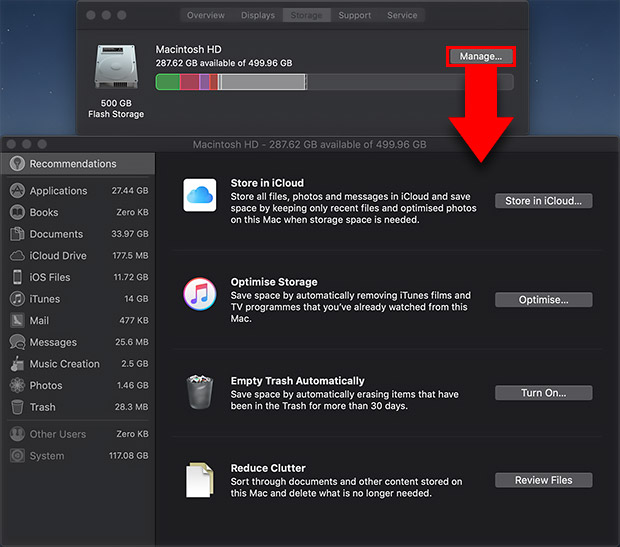
As you can see this is also how to check storage on Mac. The tool shows a breakdown of the storage space taken up on your Mac by media such as Apps, Books, Photos and others.
Let's have a look at each tool to see how it can help:
- Store in iCloud: Quickly store files (Documents, Photos and Messages) from your Mac in iCloud. When considering how to clear space on Mac, getting rid of files quickly springs to mind- However, if you need to keep the files, you can just move them to an external hard drive, or into iCloud!
Enabling this option will allow your Mac to automatically save space when it’s needed.
This is great as you’ll be able to access your files on any device using your Apple ID. However, if you have a large number of files, you’ll need to purchase more storage space than your allotted free amount (5GB)- obviously, depending on the amount of space you need, this can quickly become an expensive option.
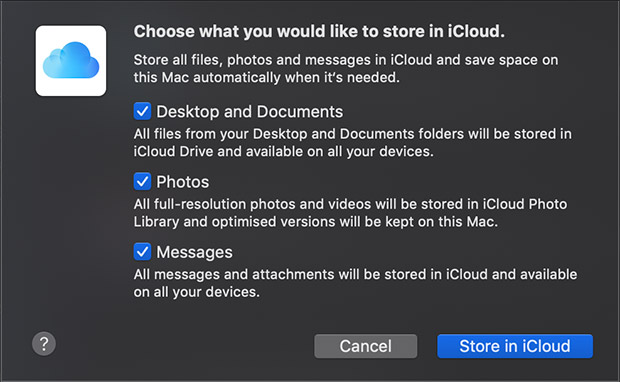
- Optimize Storage: For those who download and watch lots of movies and TV, this option can save you a lot of space and a lot of time. Enabling this option will allow your Mac to automatically remove such files (which can be HUGE depending on their length and quality) once you have watched them.
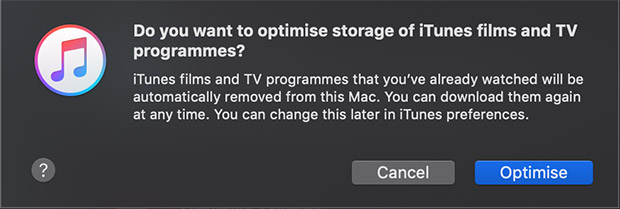
Empty Trash Automatically: Similar to the above, enabling this option allows the automatic removal of files, saving you time and space without having to keep on top of it manually. This will remove items in your Trash after 30 days of them being there. Be aware that once files have been removed from your Trash, you will not be able to retrieve them.

Side note: Many points in this article will advise the removal of unwanted files from your Mac. However, these files are not completely removed from your computer until you empty the Trash (the space is not regained until they are removed from Trash). You can manually empty it by clicking the Trash Can icon in your dock, then clicking 'Empty'.
-
Reduce Clutter: Find large and unused files on your Mac and delete them from your system. You’ll need to delete them manually, but it’s well worth it if you can remove files that you do not use.
Navigate to files that you don't need using the 'Large Files' or 'Downloads' sorters, then hit 'Delete...'. Note that this action will bypass sending the item to Trash, so it's permanent.
If you're finding unwanted files using the 'File Browser' tab, you'll need to right-click > 'Move To Trash'.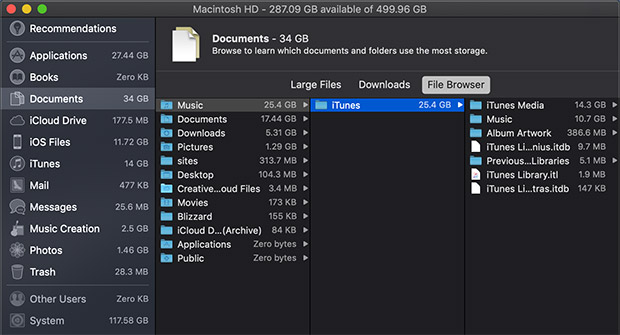
3. Find Duplicate Files Mac
The quickest way to free up space on your Mac is to automatically remove files that you don’t need. Without realizing it, you can accumulate gigabytes worth of duplicate files and folders on your computer.
The problem is that it can take so much time to find and delete these duplicates that people do not bother to do it even if they want to.
Luckily, you can use an app like Duplicate Sweeper to do this for you.
Duplicate Sweeper: Easily scan your Mac for duplicate files and photos. You can then select and remove duplicates based on your preferences. In this way, you can keep your newest version of files and remove all duplicates with a click of a button.
What duplicates can you find and remove with Duplicate Sweeper?
- Files: Scan for duplicated documents and files and remove them
- Photos: Find and delete duplicate photos and videos from your computer
- Music: Get rid of duplicate tracks and songs from your music library
In the example below, I was able to remove over 6000 files with one click. This freed up 2.3 GB of space on my MacBook. Imagine manually going through and comparing 6000 files without Duplicate Sweeper... it would have taken forever!
Find out more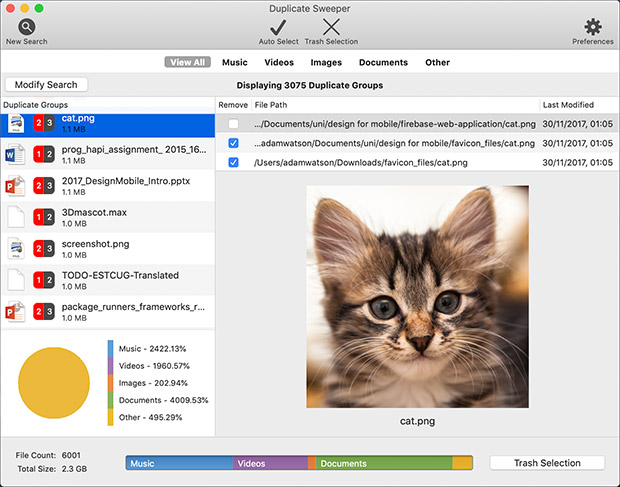
4. Unused Apps - Uninstall Programs on Mac
One of the biggest areas you should consider when looking at how to free up space on Mac is your Apps. Maybe unsurprisingly, apps on your Mac can be some of the largest files on your computer. Removing apps that you don’t use can free up a huge amount of space. Let’s list your apps by their files size:
Open Finder, then open the Applications section. Display the items as a list (using the button with 4 horizontal lines), then click the ‘Size’ header to reorder your applications by size. You can then work down the list and decide which applications you don’t use. Simply drag an application from the list into the Trash Can on your Dock to remove them.
Remember that you’ll need to empty your Trash Can to completely remove the applications from your Mac.
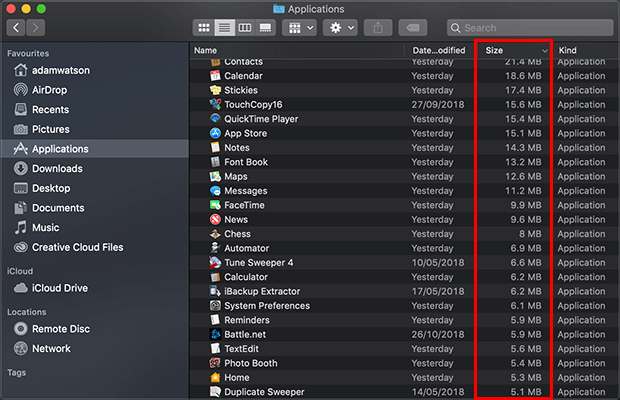
5. How to Delete Downloads on Mac
Your 'Downloads' folder can receive copious amounts of files downloaded from multiple sources. Many of these files you may have only needed to read or use once.
- Access your downloads by launching a Finder window on your Mac, then opening the "Downloads" folder.
- Select the files you want to remove (you can select them all using cmd+A).
- Right-click one of your selected files and choose "Move to Trash/Bin"
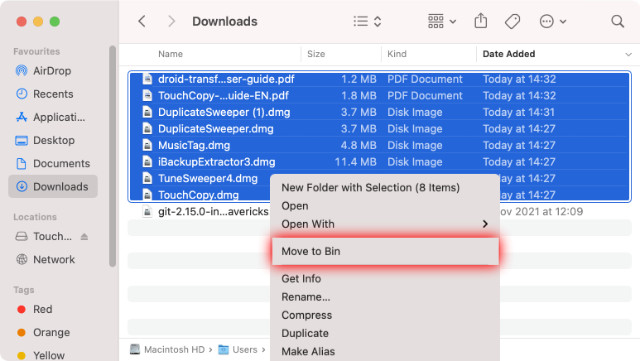
Your selected files will not be deleted just yet. At this point you have only moved the unwanted files to your trash/bin. To delete the files and reclaim your space, you'll need to empty your trash/bin.
6. Find and remove large media files
The quality of media like photo and video is constantly improving. Unfortunately, this usually means that the corresponding files are bigger than they used to be.
For this reason, your saved media could be a great place to free up some of that precious storage on your Mac.
Open Finder and look through your Pictures, Movies and Music folders. If there is media there that you don't want, select it and move it to Trash to get rid of later. If you prefer to delete this media from the associated apps like Photos and iMovie, see how to empty their trash.
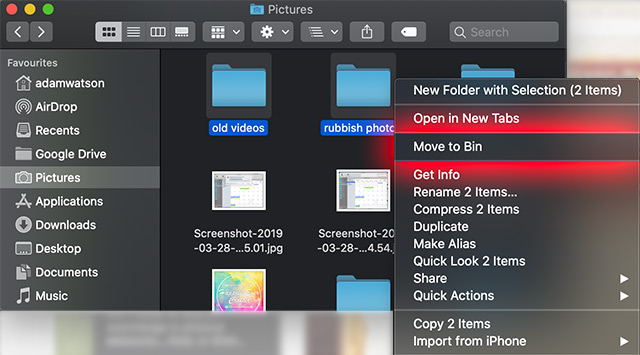
Extra: Zipped / Archived files
If you receive a zipped file (with the .zip extension), opening it will unzip the file or folder and create the files in a non-zipped form.
This will create files that you can use, but it will not remove the (now unneeded) zip file. If you've already unzipped, you can delete the .zip file.
On the flip side, you can use file archiving to compress files or folders that you don't use regularly.
Say you have a folder of documents that you only need to save for safekeeping; right-click the folder in Finder and click "Compress [file/folder name]". This will compress the files and create a .zip file.
Don't forget to delete the original, uncompressed folder in order to save the space!
7. Delete Finder/iTunes backups
Depending on the number of files, photos, messages etc that you have stored on your iPhone, iPod or iPad, its backup on your Mac can be huge.
Keeping backups of your devices is a good idea. If something was to happen to your device, your data can be restored to it (or another device) using your backup. However, these backup files can be massive, and you may never need them! For this reason, consider backing up your devices to iCloud instead – freeing up space on your Mac.
To set your device to backup to iCloud, go to Settings > (your name) > iCloud > iCloud Backup.
To initiate a backup, connect your device to a power source and also to a Wi-Fi network. Lastly, ensure that your device screen is locked and that you have enough free space in iCloud to store the backup.
How to delete backups on Mac - You can also delete the backups which you already have stored on your Mac. Here's how:
- macOS 10.15 or later: Open Finder and connect the device for which you want to see backups. Select the device from under the list of Locations. In the General section, click Manage Backups. Select a backup in the list and hit Delete if you don't want to keep it.
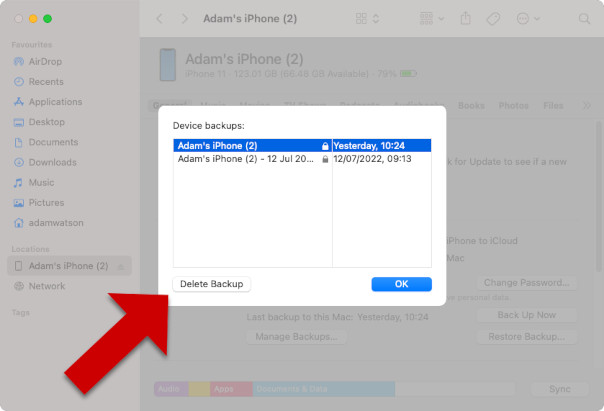
- macOS 10.14 or earlier: Open iTunes and go to iTunes > Preferences > Devices. If you don’t need the backups in the list, select and delete them!
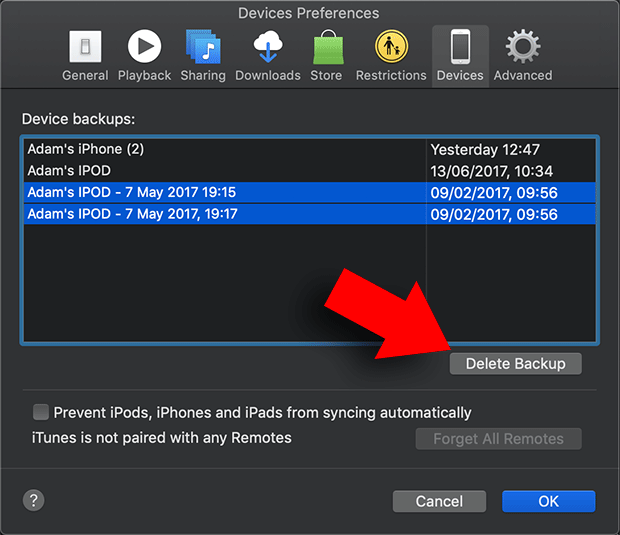
Find out: where are iTunes backups stored?
Alternatively, if you don’t want to use iCloud for backing up your data, or if you only need certain data from your backups, you could use iBackup Extractor. This handy tool allows you to access and browse your backups, and extract any important photos, messages etc. that you need. You can save this data to your computer, then delete the backup from Finder/iTunes as seen above!

8. How to Delete Temporary Files on Mac
Some of the most common questions asked are "how to clear cache on mac" and "how to delete cookies on mac". Well, let's answer those for you!
Temporary and cache are files that are stored locally in order to speed up processes. For example, images from a website that you visited can be cached, so that when you visit the page again, you don’t have to wait to download the images again, they are simply pulled in from the cache. That’s great for processes that you use regularly, but without care, your temporary and cached files can build up and eat away at your Mac’s performance.
Let’s see how to clear cache on mac – Open Finder > Go > hold ‘option’ and click ‘Library’ > Caches. Select and delete any cache files and folders that you don’t need to save space!
9. Taking out the Trash
Deleting files on your Mac usually only moves them to your Trash Can (or Bin).
This is great, because if you "delete" something by accident, you can restore it to its original location - no harm done.
However, if you are culling files on your Mac to make space, you may wonder why you are not gaining storage after clicking delete.
To permanently delete files from the Mac, you'll need to empty your Trash Can. To do this, simply click the Trash Can (or Bin) icon in your Dock.
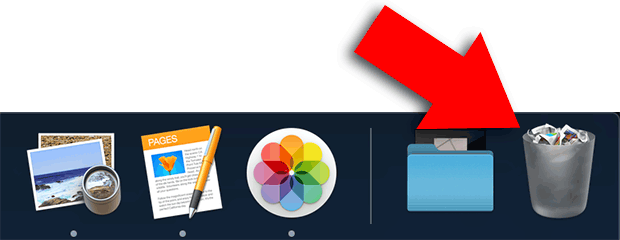
Here, you can review or restore files in your Trash/Bin.
To permanently delete all the files in your bin, click Empty. You'll be asked if you're sure, and to confirm the permanent deletion of the files.
Deleting files from Photos, iMovie and Mail apps...
Generally, you'll be able to use the steps above to permanently delete files. However, some apps have their own way to manage "deleted" files.
As such, you'll need to empty trash cans in individual apps to ensure that files are fully deleted.
An example of this can be seen in the Photos app:
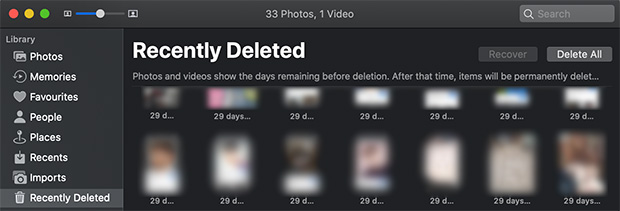
Click the "Recently Deleted" header to access the trash in the Photos app.
After "deleting" photos from the app, the files can remain in this section for up to 40 days before being automatically deleted.
If you are sure you'd like to permanently delete these photos, click "Delete All" to remove them from your hard drive.
You can use similar steps to empty trash for other apps like iMovie and Mail.
10. Move files into external storage
The majority of the methods above cover how to delete unwanted files to gain space. But what you if want to keep your files?
If you need more space on your Mac, but deleting your files is not an option, you may want to consider investing in external storage.
You can purchase external storage drives pretty cheaply nowadays.
The way this works is that you connect your external drive with your Mac via USB cable. The drive then pops up as a Location on your Mac:
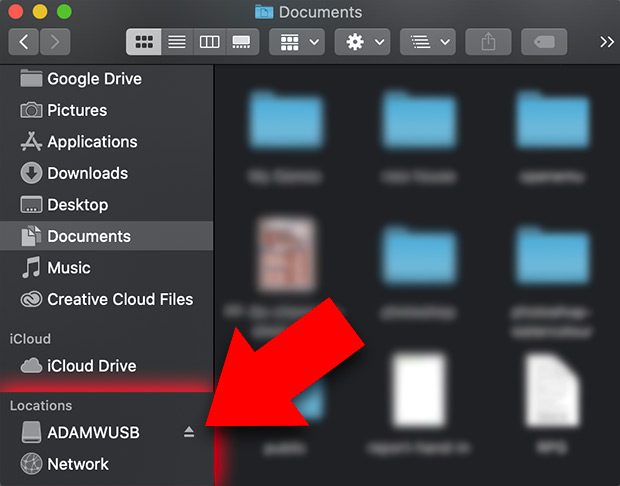
You can then drag files from your Mac onto your external drive, or cut/paste them into specific folders on your drive.
Takeaways
These are the most effective steps to make the most of the available space on your Mac in our experience.
There's a lot of information above, but this is not an exhaustive list of everything you can do to clear space on your Mac. We hope that you now have the tools that you need to breathe new life into your Mac or MacBook.
Happy spring cleaning!
 Publisher:
Publisher:Wide Angle Software


